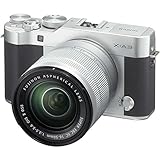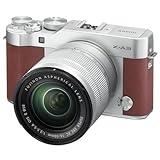Fujifilm X-A3 Review J
Fujifilm X-A3 Review
 |
The Fujifilm X-A3 is an inexpensive 24 Megapixel mirrorless camera with a classic rangefinder design. The X-A3 is targeted more toward beginners and social shooters, with its flip-up, selfie-friendly LCD serving as exhibit A. Compared to the next model up, the X-E2S, the X-A3 has a lower quality build and fewer direct controls, and also lacks the electronic viewfinder of that model. The X-A3 also uses a traditional (Bayer) color filter rather than the X-Trans filters found on the company's more expensive models, such as the X-E2S.
With an MSRP of $599 including a lens, the X-A3 is competitively priced, with peers such as the Canon EOS M10, Nikon D3400, Olympus E-PL8, Panasonic GX850 and the yes-it's-still-in-production Sony a6000. Yep, pretty crowded.
It's worth mentioning the X-A10, which is Fujifilm's entry-level model. Among other things, it has an older/lower resolution sensor, non-touch LCD and lacks 1080/60p support.
Key Features
- 24MP APS-C CMOS sensor
- 77-point contrast-detect AF system
- 3" touchscreen LCD w/180° upward tilt
- Twin control dials
- Film Simulation modes
- 1080/60p/24p video
- Wi-Fi w/remote capture
Everything there is consistent with recent Fujifilm X-series cameras, except for the aforementioned lack of the X-Trans filter and a contrast-detect-only AF system.
Compared to...
The X-A3's closest peers, in our opinion, are the Canon EOS M10, Olympus E-PL8 and Panasonic GX850. The chart below sheds some light on how they compare in terms of spec.
| Canon M10 | Fuji X-A3 | Olympus E-PL8 | Panasonic GX850 | |
|---|---|---|---|---|
| Sensor size | APS-C | APS-C | Four Thirds | Four Thirds |
| Resolution | 18MP | 24MP | 16MP | 16MP |
| Lens mount | EF-M | X-mount | Micro Four Thirds | Micro Four Thirds |
| Image stabilization | Lens-based | Lens-based | In-body | Lens-based |
| AF system | Hybrid | Contrast-detect | ||
| LCD type | 3", 180° tilt-up | |||
| Touchscreen | Yes | |||
| Built-in flash | Yes | Yes | Clip-on | Yes |
| Flash sync | 1/200 sec | 1/180 sec | 1/250 sec | 1/50 sec |
| Burst rate (w/AF) | 2.2 fps | 3 fps | 3.7 fps | 6 fps |
| # control dials | 1 | 2 | 1 | 1 |
| Video | 1080/30p | 1080/60p | 1080/30p | 4K/UHD |
| Wireless | Wi-Fi w/NFC | Wi-Fi | Wi-Fi | Wi-Fi |
| Battery life | 255 shots | 410 shots | 350 shots | 210 shots |
| Dimensions | 108x67x35mm | 117x57x40mm | 117x68x38mm | 106x65x33mm |
| Weight | 301 g | 339 g | 374 g | 336 g |
Aside from its 24 Megapixel sensor, twin control dials and excellent battery life, the X-A3 otherwise sits in the middle of the above group. If it had a hybrid (contrast + phase detection) AF system and 4K video, it would more readily rise to the top.
Potential X-A3 buyers may also be interested in where it fits in Fujifilm's line-up. It sits above the entry-level X-A10 but considerably below the X-E2S. Here's a quick comparison of what each of these cameras offer, and whether it's worth spending more (or less) for something other than the X-A3.
| Fuji X-A10 | Fuji X-A3 | Fuji X-E2S | |
|---|---|---|---|
| Body w/kit lens | $499 | $599 | $999* |
| Sensor | 16MP Bayer | 24MP Bayer | 16MP X-Trans |
| AF system | Contrast-detect | Contrast-detect | Hybrid |
| AF points | 49 | 77 | 77 |
| Max ISO | 25600 | 25600 | 51200 |
| LCD | 3", flip-up | 3", flip-up | 3", fixed |
| Touchscreen | No | Yes | No |
| EVF | None | None | Yes |
| Max burst | 6 fps | 6 fps | 7 fps |
| # control dials | 1 | 2 | 1 |
| Video | 1080/30p | 1080/60p | 1080/60p |
| Battery life (CIPA) | 410 shots | 410 shots | 350 shots |
* includes a faster, more expensive kit lens (F2.8-4) than the X-A10 and X-A3 (F3.5-5.6)
Unless you're really strapped for cash, there's no reason to buy the X-A10 – which has generations-old Fuijfilm tech – when the X-A3 is available. Whether you want to pay significantly more than the price of the X-A3 is another story, and depends on your needs and budget. The X-E2S (read our review) comes with a better build and numerous dials, customizable controls, and improved AF performance.
Review history:
July 12, 2017: Originally published using camera with v1.3 firmware.
July 20, 2017: Updated to reflect firmware v2.0 image quality improvements.
July 20, 2017: Updated to reflect firmware v2.0 image quality improvements.
Buying Options
Support DPReview. Shop with





تعليقات
إرسال تعليق